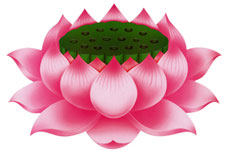Buddhist Studies:
Symbols/Iconography
The Symbol of the Lotus

Lotuses are symbols of purity and ‘spontaneous’ generation and hence symbolize divine birth. According to the Lalitavistara, ‘the spirit of the best of men is spotless, like the new lotus in the [muddy] water which does not adhere to it’, and, according to esoteric Buddhism, the heart of the beings is like an unopened lotus: when the virtues of the Buddha develop therein the lotus blossoms. This is why the Buddha sits on a lotus in bloom. In Tantrism, it is the symbol of the feminine principle. The lotuses are usually differentiated by their colour and grouping, in three or five flowers, which may or may not be combined with leaves.
White lotus
This symbolizes Bodhi, the state of total mental purity and spiritual perfection, and the pacification of our nature. It generally has eight petals corresponding to the Noble Eightfold Path of the Good Law. It is the lotus found at the heart of the Garbhadhatu Mandala, being the womb or embryo of the world. It is characteristic of the esoteric sects, and the lotus of the Buddhas.
Red lotus
This symbolizes the original nature of the heart (hrdaya). It is the lotus of love, compassion, passion, activity and all the qualities of the heart. It is the lotus of Avalokitesvara.
Blue lotus
This is the symbol of the victory of the spirit over the senses, of intelligence and wisdom, of knowledge. It is always represented as a partially opened bud, and (unlike the red lotus) its centre is never seen. It is the lotus of Manjusri, and also one of the attributes of Prajnaparamita, the embodiment of the ‘perfection of wisdom’.
Pink lotus
This is the supreme lotus, generally reserved for the highest deity, sometimes confused with the white lotus it is the lotus of the historical Buddha.
Purple lotus
This is the mystic lotus, represented only in images belonging to a few esoteric sects. The flowers may be in full bloom and reveal their heart, or in a bud. They may be supported by a simple stem, a triple stem (symbolizing the three divisions of Garbhadhatu: Vairocana, lotus and vajra), or a quintuple stem (symbolizing the Five Knowledges of Vajradhatu). The eight petals represent the Noble Eightfold Path and the eight principal acolyte deities of the central deity on the mandalas. The flowers may also be depicted presented in a cup or on a tray, as a symbol of homage.

